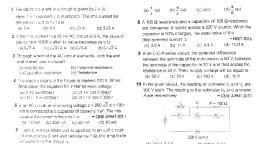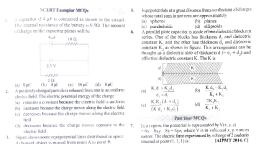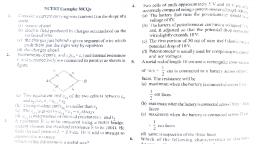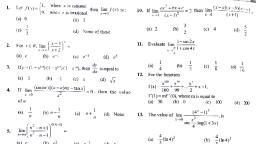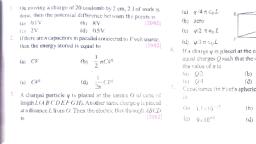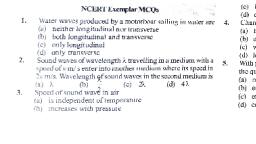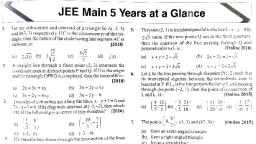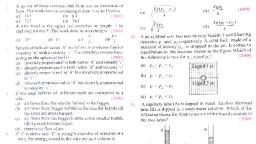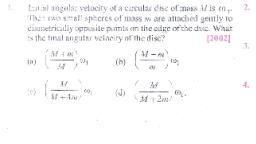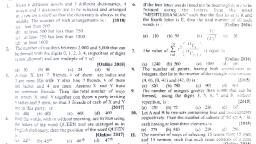Question 1 :
$S_1$ : A body having non-uniform velocity will have zero acceleration.<br/>$S_2$: A charge particle is free to move in an electric field. It will travel along a line of force, if it has some initial velocity in the direction of a non-zero acute angle with the line of force.<br/>$S_3$: Stationary waves are called 'stationary' because in them everything remains at rest. Find the correct alternative from the following($F$: False and $T$: True):<br/>
Question 2 :
Three charged particles are in equilibrium under their electrostatic forces only. which of the following statements is true for the system.
Question 3 :
A small metallic ball is suspended in a uniform electric field with the help of an insulated thread. If high energy $X-$ray beam falls on the ball, the ball will be deflected in the direction of the field.<br>
Question 4 :
<span class="wysiwyg-font-size-small"><span class="wysiwyg-font-size-small"><p class="wysiwyg-text-align-left">At the centre of a cubical box $+ Q$ charge is placed. The value of total flux that is coming out of each face is :</p>
Question 5 :
A charged oil drop is suspended in a uniform field of 3 x 10<sup>4</sup>  v/m so that it neither falls nor rises. The charge on the drop will (Take the mass of the charge  = 9.9 x 10<sup>-15</sup> kg  and g = 10 m/s<sup>2</sup>  )
Question 6 :
A body has $80$ micro-coulomb of negative charge. Number of additional electrons on it will be :
Question 7 :
A dipole is placed in a uniform electric field with its axis parallel to the field. It experiences :
Question 8 :
Two point charges having equal charges separatedby $1 m$ distance experience a force of $8 N$. What willbe the force experienced by them, if they are held inwater, at the same distance?<br>(Given, $K_{water} = 80$ )
Question 9 :
An electric dipole is placed at an angle of ${30}^{o}$ with an electric field of intensity $2\times {10}^{5}N{C}^{-1}$. It experiences a torque of $4Nm$. Calculate the charge on the dipole if the dipole length is $2cm$ :
Question 10 :
Five balls numbered $1$ to $5$ are suspended using separate threads. Pairs $(1,2), (2,4), (4,1)$ show electrostatic attraction while pairs $(2,3), (4,5)$ show repulsion. There ball $1$ must be
Question 11 :
The sum of all electromagnetic forces between different particles of a system of charged particles is zero:<br/>
Question 12 :
A charge of magnitude $q$ is divided into two parts such that force between resulting two charges is maximum when separated through some distance $r$. The division of charges would be
Question 13 :
Which of the following is not a unit of charge ?
Question 14 :
$\begin{array} { l } { \text { Four equal charges } Q \text { are placed at the four corners of a square of side a each. Work done i } } \\ { \text { removing a charge } - Q \text { from its centre to infinity is: } } \end{array}$
Question 15 :
The electric field in a certain region is acting radially outward and is given by $E=Ar$. A charge contained in a sphere of radius '$a$' centered at the origin of the field, will be given by :<br/>
Question 16 :
A sphere of radius $4cm$ is given a charge of $16\mu C$. If the sphere is situated in air then the electric field at a points at a distance of $2cm$ from the centre of the sphere is:
Question 17 :
Electric charges are distributed in a small volume. The flux of the electric field through a spherical surface of radius $10$ cm surrounding the total charge is $25$ V-m. The flux over a concentric sphere of radius $20$ cm will be :
Question 18 :
Two similar and identical metal spheres $A$ and $B$ repel each other with a force of $2\times10^{-5} N$. AThird identical uncharged sphere $C$ is touched with $A$ and then placed at the mid-point of $AB$. What is the net electric force on $C$?
Question 19 :
Select the correct statement : (Only force on a particle is due to electric field)<br>
Question 20 :
An electron and a proton are both released from rest 1 meter from a large stationary negative charge, considering only the force from the large stationary negative charge on the proton and electron. Which of the following is true?
Question 21 :
Two coaxial coils are very close to each other and their mutual inductance is $5$ mH. If a current $50\sin 500r$ is passed in one of the coils then the peak value of induced e.m.f. in the secondary coil will be?
Question 22 :
The surface charge density on a copper sphere is $\sigma$. So the intensity of electric field on its surface will be:
Question 23 :
If the radius of a sphere doubled without changing the charge on it, then electric flux originating form the sphere is:
Question 24 :
A point electric is dipole is at the origin of coordinate with its dipole moment along the positive Z-axis. Consider a circular disc of radius R with its center z= modulus of the electric flux due to the dipole through the disc is maximum R is equal to
Question 25 :
A charge q is accelerated through a potential difference V. It is then passed normally through a uniform magnetic field, where it moves in a circle of radius r. The potential difference required to move it in a circle of radius $2r$ is?

